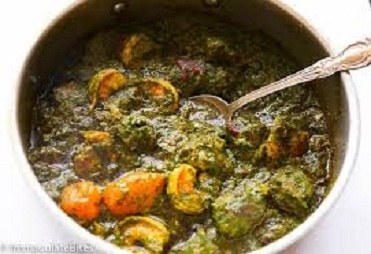Cassava Leaf Soup / Cassava Leaves / Benefits
Cassava leaf (Casada Lif) is Sierra Leone’s national dish. In 80 nations around the world, the cassava plant is consumed by 500,000 million people.

Cyanogenic glycosides, which can be broken down to release hydrogen cyanide, are found in both the leaves and the root.
To get rid of the poison in cassava leaves or roots, follow these steps:
- Firstly, boil the leaves until they get a dark army green color.
- After boiling the leaves, some people discard the water.
- Finally, cook it until it is soft and well-done by boiling, baking, roasting, or frying it.
What is a cassava leaf?
Cassava is a perennial plant with large, almost palmate (fan-shaped) leaves that are similar to those of the related castor-oil plant but are more deeply divided into five to nine lobes.
Dahlia tubers are reminiscent of the fleshy roots. Low herbs to branching shrubs and thin unbranched trees are among the many kinds.
What is cassava leaf good for?
Vitamins – Cassava leaf has a vitamin content comparable to carrots, which is beneficial to overall health.
Vitamin C, found in cassava leaves, is a potent antioxidant that can help prevent cardiovascular disease, strokes, and cancer.
B vitamins are also important for mood, vigor, and metabolism.
What are the side effects of cassava leaves?
Raw cassava leaves contain cyanide, a toxic chemical that can result in poisoning, paralysis, rapid respiratory failure, and death. This is one of the most serious adverse effects of eating raw cassava leaves, roots, or tubers.
What is the English name for cassava leaf?
Manihot esculenta
Manihot esculenta, also known as cassava (/ksv/), manioc, or yuca (among other regional names), is a South American woody shrub belonging to the Euphorbiaceae spurge family.
Tips on How to Cook Cassava Leaf Soup
The soup uses cassava leaves as a base which is the leaves of the cassava plant.
- Firstly, it’s best if you can get fresh young cassava leaves because it’s better as they will cook much quicker.
- Secondly, pounding or blending the cassava leaves will cook faster. It adds depth of flavor to the sauce while thickening the stew.
- Lastly, younger and tender cassava leaves cook much quicker for about 30-45 minutes while older or not finely minced, might need to simmer for 60-75 minutes.
Cassava leaf soup goes by several different names like saka saka, palava, pondu, and mpondu.
It is a simple, yet tasty and important soup that is widely consumed in many parts of Africa especially in countries like Sierra Leone, Liberia, Congo, Nigeria, etc.
Cassava leaf soup is always served over steamed rice or plantains
Cassava Leaf Soup Recipe
To make this African dish/stew in Nigeria you need the following:
Ingredients
- 2500 g cassava Leaf
- 2 Red onion (Chopped)
- 5 Tbsps. Palm oil
- 4-5 tablespoons peanut butter or groundnut pureé substitute for 150 g pumpkin seeds, sesame seeds or soy nuts pureé
- 2 cubes Maggie
- 1 scotch bonnet
- 200 g shaki
- 1 Kg chicken drumsticks
- 250 g diced lean beef
How to Prepare Cassava Leaves Soup
- Firstly, season the chicken, beef, and shaki with salt, Maggi, onions, and fresh herbs in a large pot,
- Secondly, cook until tender. Boil the chicken separately from the beef/shaki as they cook at a different pace and the stock is different.
- Thirdly and most importantly, do not discard the stock once the beef/chicken is cooked.
- Fourthly, heat the oil in another or the same large pot; add the chopped onions and sauté until browned and fragrant (about 1-2 minutes).
- After that, add in the chicken/beef/shaki along with half the stock, reduce the heat slightly, and allow simmering. Stir occasionally. (5 minutes)
- Then, add in the peanut butter or groundnut pureé then add the remaining stock; cook for another 5 minutes.
- Add also, the already cooked cassava leaves. Mix in thoroughly till fully integrated and continue cooking for about 5 – 10 more minutes. (Feel free to cover the pot at this stage)
- Lastly, adjust seasonings to taste (Mixed herbs, salt, water, and oil) to taste and desired consistency.
Recipe Notes
Nutritional Info per Serving: Cal: 480 | Carbs: 23.7 g | Pro: 51 g | Fat: 22.3 g
Variation: To make White Cassava Leaves soup simply replaces the Palm oil with coconut oil. This small substitution brings a whole other flavor profile to the mix.
Questions People Also Ask
- What Are Cassava/ Cassava Leaves?
Cassava (Manihot esculenta) is a root vegetable used for both culinary purposes and in folk medicines.
Cassava is an important tuber crop (alongside potatoes and yams) and one of the most important sources of carbohydrates in the developing world.
The meaty flesh is often described as having a mild, sweet, somewhat nutty taste.
The root of the plant is rich in vitamin C, while the leaves contain beta-carotene, lysine, and other compounds beneficial to the skin and metabolism.
The leaves can also be eaten, as you can see in this recipe. Cassava leaves are a rich source of protein, minerals, and vitamins.
They are highly fibrous, dense, and grassy.
- Health Benefits of Eating Cassava Leaves (Yuca Leaves)
- Cassava leaves contain lysine, isoleucine, leucine, valine, and lots of arginine which are not common in green leafy plants, thus making it a great protein source.
- The astonishing protein content of cassava leaves is also comparable to sweet potato leaves and peanut leaves.
- The protein found in cassava leaves is about 10 times more than that in the roots.
- Cassava Leaves contain a good range of minerals and vitamins (2g/100g of leaves) that surpass most legumes (except soya beans) and are comparable to that of liver and eggs which is great.
- They are gluten-free and low in Calories – 100 grams of cooked cassava leaves only contain about 37 calories making it great for weight loss.
Content – Cassava leaves contain Vitamin C a powerful antioxidant for helping to prevent cardiovascular disease, strokes, and cancer.
- Also B Vitamins for good mood, vitality, and metabolism.
- Cassava leaves contain Beta Carotene which is a powerful antioxidant that prevents cancer and repairs DNA damage.
- Also, potassium for water regulation and cardiovascular health,
- Lastly, phosphorus, and calcium for strong bones, iron, and copper for anemia, zinc for a strong immune system, magnesium, and manganese for strong bones and enzyme production.
- Are Cassava Leaves Poisonous?
Cassava roots, peels, and leaves should not be eaten raw because they contain cyanogenic glucosides, linamarin, and lotaustralin.
These are decomposed by linamarase, a naturally occurring enzyme in cassava, liberating hydrogen cyanide (HCN).
- Is Cassava Root Good For Fertility?
Cassava is known globally for its effects on fertility.
It helps with growing the chance of twins, but also with fertility. Many women use the supplement to increase fertility even when they’re not trying for twins.
The Cassava plant contains a chemical that causes hyper-ovulation
- Why Is Cassava So Important?
Cassava is the most important tropical root crop. Its starchy roots are a major source of dietary energy for more than 500 million people.
- How Do I Make Cassava Safe To Eat?
To make cassava safe to eat first, peel and slice the cassava and then cook it thoroughly either by baking, frying, boiling or roasting.
This process reduces the cyanogenic glycosides to safe levels.
- Where It Grows
Cassava is a perennial woody shrub with an edible root, which grows in tropical and subtropical areas of the world.
Cassava originated from tropical America and was first introduced into Africa in the Congo Basin by the Portuguese around 1558.
Today, it is a dietary staple in much of tropical Africa.
- Cassava Leaf near Me: Where To Buy
In Africa, you can easily get it in the local market / nearby farm for a big old bunch of cassava leaves to take home and pound or grind.
You can even order online.
However, for those in the diaspora, you would have to head to your African store/local ethnic market to buy already minced or pounded Cassava Leaf from either the fridge or the freezer section.



